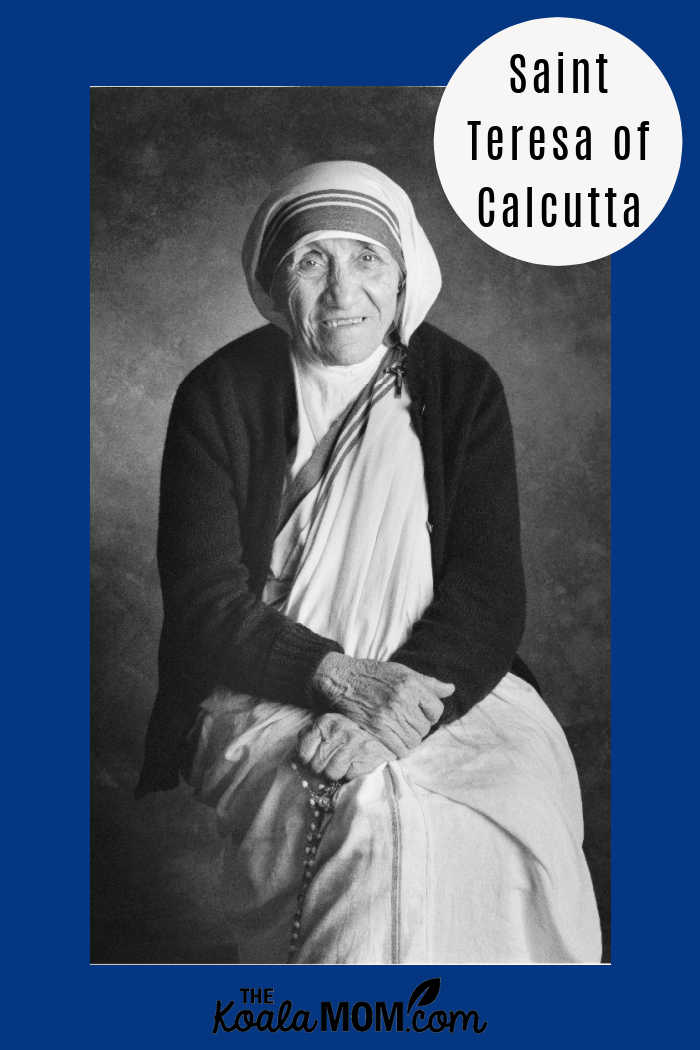Just over one hundred years ago, a young girl named Agnes was born on August 26th in Yugoslavia. She would someday become known as Mother Teresa of Calcutta. I didn’t join the Catholic Church until ten years after her death, but I still remember hearing about her. This little Catholic nun caught the attention of the entire world for her work in India’s slums.

Mother Teresa’s Early Years
Agnes was born into a well-to-do family on August 26, 1910. Her father was a partner in a successful construction business and involved in politics. However, his death when Agnes was only 7 changed their family. Her mother had to work to support her three children. Despite this, she often took in others who were worse off than they were, teaching Agnes compassion and generosity.
In her childhood, Agnes heard about missionaries to other countries and was fascinated. At age 18, she joined the Sisters of Loreto. She left home to begin her religious life in Ireland. I can only imagine the courage and faith it took to leave the comforts of home and family for a new life so far away.
She was in Ireland for only a year before being sent on another long journey to another new country—India. Here, Agnes finished her novitiate. At age 21, made her vows as a Sister of Loreto. She took the name Teresa to honour Saint Teresa of Avila and Saint Therese of Lisieux.
Mother Teresa’s Work in India
For the next fifteen years, Sister Teresa worked as a teacher at St. Mary’s School for Girls in Calcutta. She made her final vows in 1937. From then on, her students and the other sisters called her Mother Teresa. In 1944, she became the principal of St. Mary’s. She was known as a woman of profound prayer, with a deep lover for her sisters and students.
In 1946, Mother Teresa went to Darjeeling for her annual retreat. This began her famous call. On the train, she felt deeply Jesus’ thirst for love. Over the next few months, Jesus revealed more fully to her what He was calling her to do. He wanted Mother Teresa to be His light to the poorest of poor, those who lived in ignorance of Him and His love.
Mother Teresa spent the next two years in testing and discernment. Finally, in 1948, she founded the Missionaries of Charity, as Jesus had asked her. Putting on her white and blue habit (modeled on an Indian sari), she left her comfortable life at St. Mary’s for the slums of India. Perhaps each of her earlier moves—from Yugoslavia to Ireland and then from Ireland to India—had helped prepare her for this move, which surely required all of her faith and courage.
Living in a tiny hut, Mother Teresa began each day with prayer and the Eucharist. Then she went out to serve as she was needed. She taught the children of the slums and offered basic medical care, for which she’d done some training with another group of nuns.
The Missionaries of Charity
Word of Mother Teresa’s work spread quickly and she soon had help. Some of her former students joined her as sisters. Others offered food, clothing, medical supplies, money, and buildings to use.
In 1950, only two years after Mother Teresa began her work, the Missionaries of Charity were officially established in the Diocese of Calcutta. Within a decade, she began sending nuns to other parts of India. In 1965, she opened a house in Venezuela, then Rome, then Tanzania, and even in almost every communist country.
She founded other branches of the Missionaries of Charity, including opportunities for lay people to get involved. She also received numerous awards for her work, most notably the Nobel Peace Prize in 1979. One little woman began taking care of the people nobody else wanted to notice, and the world noticed.
Mother Teresa’s Death and Legacy
Mother Teresa remained active in the Missionaries of Charity up until her death. She continued to serve as the head of the Missionaries of Charity until March, 1997, when she blessed her successor. She made a final trip abroad and visited Pope John Paul II. Then in September, she died.
Mother Teresa was given a state funeral before her burial at the Missionaries of Charity Mother House. Her tomb has become a place of pilgrimage and prayer. Pope John Paul II opened her cause for canonization just two years after her death. She was beatified by Pope Saint John Paul II in 2003 and canonized by Pope Francis in 2016.
Her feast day is celebrated on September 5. She is the patron saint of World Youth Day, the Missionaries of Charity, and Calcutta.
After Mother Teresa’s death, the media exploded with news that, for much of her ministry, she had felt very alone. While she was doing God’s work in the slums of India, she felt rejected and abandoned by Him. Despite this, she never questioned the vision and calling God had given her. Instead, she remained faithful to her work, accepting this feeling of abandonment as a taste of the rejection Jesus feels from us.
For more about Mother Teresa, including quotes, photos and prayers, visit MotherTeresa.org.
Mother Teresa: No Greater Love is a documentary about this saint that combines historical and modern footage with the story of her life. To teach children about Mother Teresa, check out the Holy Heroes Glory Story “The Gospel on Five Fingers.” If your child has a particular connection to Mother Teresa, there are also numerous resources and gift ideas.

No Responses Yet